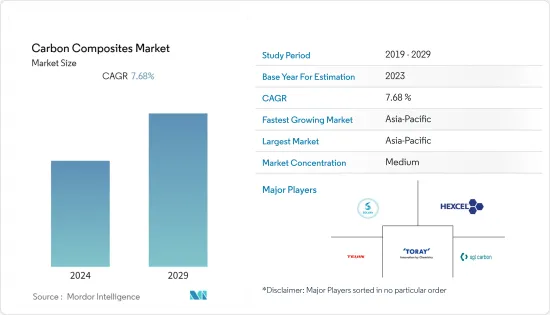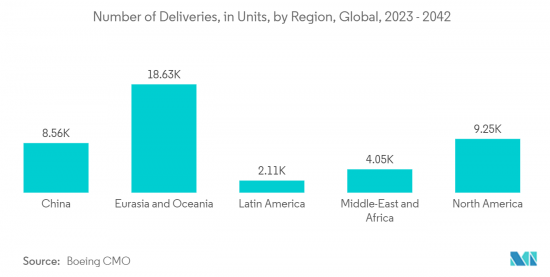PUBLISHER: Mordor Intelligence | PRODUCT CODE: 1404367

PUBLISHER: Mordor Intelligence | PRODUCT CODE: 1404367
Carbon Composites - Market Share Analysis, Industry Trends & Statistics, Growth Forecasts 2024 - 2029

The carbon composites market is estimated to be at 205.90 kilotons by the end of this year. It is projected to reach 298.10 kilotons in the next five years, registering a CAGR of over 7.68% during the forecast period.
COVID-19 had a negative impact on the carbon composites sector. Global lockdowns and severe rules enforced by governments resulted in a catastrophic setback as most production hubs were shut down. Nonetheless, the business has been recovering since 2021 and is expected to rise significantly in the coming years.
Key Highlights
- The major factors driving the market are increasing demand from the aerospace and defense industry and increasing demand from the wind energy sector.
- However, the high cost of manufacturing in comparison to other composites and the presence of substitutes are hindering the market growth.
- Nevertheless, the growing adoption of carbon composites in 3D printing and increasing demand from fuel cell electric vehicles (FCEVs) will be the market opportunities.
- The Asia-Pacific region accounts for the highest market share and is expected to dominate the market during the forecast period.
Carbon Composites Market Trends
Aerospace and defense applications to dominate the market
- The aerospace and defense industry is the largest end-user of the carbon composite market. Initially, aerospace manufacturing used to rely heavily on metals like aluminum, steel, and titanium, which used to account for around 70% of the total aircraft weight. However, in recent years, owing to increasing preferences for properties like weight reduction, extreme resistance, insulation, and radar absorption, the usage of carbon composites in aerospace manufacturing has been growing rapidly.
- These composites consist of carbon fibers embedded in a carbon matrix. These composite materials also bring down the maintenance cost of the airplane as the materials do not rust or corrode.
- In the aerospace industry, some key applications of carbon-fiber-based composites include their use in manufacturing aircraft parts, such as clips, cleats, brackets, ribs, struts, stringers, chips, wing-leading edges, and other special parts.
- Moreover, the aerospace industry is also exploring the uses of these composites in larger structures, like wing torsion boxes and fuselage panels. In the defense industry, carbon composites are used in missile defense, ground defense, and military marine.
- According to the Boeing Commercial Outlook 2023-2042, with a resurgence in international traffic and domestic air travel back to pre-pandemic levels, the company is projected to exhibit a global demand for 42,595 new commercial jets by 2042, valued at USD 8 trillion.
- North America accounts for the largest share with 9,250 deliveries, followed by Eurasia and China, with the total deliveries of new airplanes estimated to be 9,645 units by 2042, indicating rising demand from the industry.
- In 2022, Airbus, one of the major aircraft manufacturers across the world, delivered around 661 commercial aircraft to 84 customers, which is an 8% increase compared to 2021. It also has received an additional 820 net new orders in 2022. At the end of 2022, Airbus' backlog was 7,239 aircraft, the highest number since 2019. On the other hand, Boeing has reported around 774 commercial orders for 2022 and has delivered around 480 aircraft in 2022.
- Hence, due to the aforementioned factors, the aerospace and defense sector is expected to dominate the market studied.

Asia Pacific to dominate the market
- Asia-Pacific accounts for the highest share of the global carbon composites market. Most of the demand for carbon composites comes from applications in aerospace and defense, automotive, sports and leisure, etc.
- Carbon composites have been witnessing tremendous demand in the automotive industry owing to their high strength-to-weight ratios, corrosion resistivity, and workability features. They have been replacing metals in various automotive applications due to their lightweight but tough features, which contribute to lesser fuel consumption.
- According to the Organisation Internationale des Constructeurs d'Automobiles (OICA), vehicle production in China reached a total of 27.02 million units in 2022, an increase of 3% over 2021 for the same period. China's auto market experienced growth in 2022 despite the impact of several negative factors, including the outbreak of COVID-19, a structural chip shortage, and local geopolitical conflicts.
- According to the International Trade Administration (ITA), China remains the world's largest auto market in terms of both annual sales and production. Domestic production is expected to reach 35 million units by 2025.
- The Indian automotive industry showed a positive development with remarkable growth across various sectors. According to the Society of Indian Automobile Manufacturers (SIAM), the automotive industry in the country produced a total of 2,59,31,867 vehicles, including passenger vehicles, commercial vehicles, three-wheelers, two-wheelers, and quadricycles from April 2022 to March 2023, registering a growth of around 12.5% compared to April 2021-March 2022.
- According to statistics released by the Japan Automobile Dealers Association and the Japan Light Motor Vehicle Association, a total of 4,201,321 new cars were sold in Japan in 2022, down by 5.6% Y-o-Y, marking the fourth consecutive year of decline. The continuing global shortage of semiconductors has forced automakers to limit production.
- Furthermore, the aerospace and defense industry is the largest end user of the carbon composites market. With increasing preferences for properties like weight reduction, extreme resistance, insulation, and radar absorption, the usage of carbon composites in aerospace manufacturing has been growing rapidly.
- According to a press release from the aerospace company Airbus, in April 2023, over the next 20 years, China's air traffic is projected to grow at an annual rate of 5.3%, well above the global average of 3.6%. This would require 8,420 passengers and freighters by 2041, or more than 20% of the world's need for new aircraft over the next 20 years, around 39,500.
- According to the International Air Transport Association (IATA) Report, India is poised to become the third-largest aviation market in the world by the end of the forecast period, overtaking China and the United States as the world's third-largest air passenger market by 2030.
- Moreover, carbon composites are increasingly used in sports equipment owing to their superior strength, lightweight, and toughness. Thus, the rising demand for sports goods is anticipated to benefit the market's growth over the forecast period.
- According to official data, China's electronics sector recorded stable growth in 2022, supporting solid growth in terms of production and investment. According to the Ministry of Industry and Information Technology, the value added of major enterprises in the sector increased by 7.6% over the same period in 2021, exceeding the value added of all industries by four percentage points. Thus, a significant boost in demand for electronics goods supports the demand for carbon composites from the industry.
- The sports equipment market in China has witnessed growth owing to the Beijing Winter Olympic Games in 2022. The craze of the Olympics accelerated the sports industry in the country. Sports equipment makers and industry practitioners expect the sector to fuel consumers' appetite for sports activities and consumption.
- All the above-mentioned factors are expected to drive the market for carbon composites in the coming years. Asia-Pacific is expected to dominate the market studied during the forecast period.
Carbon Composites Industry Overview
The global carbon composites market is partially fragmented in nature. The major players (not in any particular order) include Toray Industries Inc., Solvay, Hexcel Corporation, Teijin Limited, and SGL Carbon SE, among other companies.
Additional Benefits:
- The market estimate (ME) sheet in Excel format
- 3 months of analyst support
TABLE OF CONTENTS
1 INTRODUCTION
- 1.1 Study Assumptions
- 1.2 Scope of the Study
2 RESEARCH METHODOLOGY
3 EXECUTIVE SUMMARY
4 MARKET DYNAMICS
- 4.1 Drivers
- 4.1.1 Increasing Demand from the Aerospace and Defense Industry
- 4.1.2 Increasing Demand from the Wind Energy Sector
- 4.2 Restraints
- 4.2.1 High Cost for Manufacturing in Comparison to Other Composites
- 4.2.2 Presence of Substitutes
- 4.3 Industry Value Chain Analysis
- 4.4 Porter's Five Forces Analysis
- 4.4.1 Bargaining Power of Suppliers
- 4.4.2 Bargaining Power of Consumers
- 4.4.3 Threat of New Entrants
- 4.4.4 Threat of Substitute Products and Services
- 4.4.5 Degree of Competition
5 MARKET SEGMENTATION (Market Size in Volume)
- 5.1 Matrix
- 5.1.1 Hybrid
- 5.1.2 Metal
- 5.1.3 Ceramics
- 5.1.4 Carbon
- 5.1.5 Polymer
- 5.1.5.1 Thermosetting
- 5.1.5.2 Thermoplastic
- 5.2 Process
- 5.2.1 Prepeg Layup Process
- 5.2.2 Pultrusion and Winding
- 5.2.3 Wet Lamination and Infusion Process
- 5.2.4 Press and Injection Processes
- 5.2.5 Other Processes
- 5.3 Application
- 5.3.1 Aerospace and Defense
- 5.3.2 Automotive
- 5.3.3 Wind Turbines
- 5.3.4 Sport and Leisure
- 5.3.5 Civil Engineering
- 5.3.6 Marine Applications
- 5.3.7 Other Applications
- 5.4 Geography
- 5.4.1 Asia-Pacific
- 5.4.1.1 China
- 5.4.1.2 India
- 5.4.1.3 Japan
- 5.4.1.4 South Korea
- 5.4.1.5 ASEAN Countries
- 5.4.1.6 Rest of Asia-Pacific
- 5.4.2 North America
- 5.4.2.1 United States
- 5.4.2.2 Canada
- 5.4.2.3 Mexico
- 5.4.3 Europe
- 5.4.3.1 Germany
- 5.4.3.2 United Kingdom
- 5.4.3.3 France
- 5.4.3.4 Italy
- 5.4.3.5 Rest of Europe
- 5.4.4 South America
- 5.4.4.1 Brazil
- 5.4.4.2 Argentina
- 5.4.4.3 Rest of South America
- 5.4.5 Middle East and Africa
- 5.4.5.1 Saudi Arabia
- 5.4.5.2 South Africa
- 5.4.5.3 Rest of Middle East and Africa
- 5.4.1 Asia-Pacific
6 COMPETITIVE LANDSCAPE
- 6.1 Mergers and Acquisitions, Joint Ventures, Collaborations, and Agreements
- 6.2 Market Ranking Analysis
- 6.3 Strategies Adopted by Leading Players
- 6.4 Company Profiles
- 6.4.1 Carbon Composites Inc.
- 6.4.2 China Composites Group Corporation Ltd
- 6.4.3 Epsilon Composite
- 6.4.4 Hexcel Corporation
- 6.4.5 Mitsubishi Chemical Corporation
- 6.4.6 Nippon Carbon Co. Ltd
- 6.4.7 Plasan
- 6.4.8 Rockman
- 6.4.9 SGL Carbon
- 6.4.10 Solvay
- 6.4.11 Teijin Limited
- 6.4.12 Toray Industries Inc.
7 MARKET OPPORTUNITIES AND FUTURE TRENDS
- 7.1 Growing Adoption of Carbon Composites in 3D-Printing
- 7.2 Increasing Demand from Fuel Cell Electric Vehicle (FCEV)




